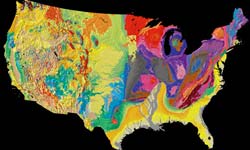 |
 |
Geologic Maps
 A geologic map uses a combination of lines, symbols, and colors to show the composition and structure of earth materials and their distribution across and beneath the Earth's surface. Geologic maps describe the rocks and soils at the surface, provide information about what rocks lie at depth, describe the ages of rocks and soils, and show where featureslie, such as earthquake faults and landslides. Geologic maps are made by studying the rocks and materials exposed at the surface and depicting information about those rocks on a map.
A geologic map uses a combination of lines, symbols, and colors to show the composition and structure of earth materials and their distribution across and beneath the Earth's surface. Geologic maps describe the rocks and soils at the surface, provide information about what rocks lie at depth, describe the ages of rocks and soils, and show where featureslie, such as earthquake faults and landslides. Geologic maps are made by studying the rocks and materials exposed at the surface and depicting information about those rocks on a map.
Why geologic maps are made and how they are used?
Geologic information shown on maps is necessary for countless reasons: from finding natural resources (water, minerals, oil, and gas) to evaluating potential hazards (earthquakes, landslides, floods, and volcanic eruptions) to describing a fundamental part of the environment that controls distribution of plants and animals. General-purpose geologic maps address all of these themes, and are an important national data base in the earth sciences.
What do maps show in the following areas?
A. Natural Resources
- Ground-water
Geologic maps delineate the likely size and depth of high permeability geologic units, such as gravel deposits and porous sandstone. Likely barriers and conduits for ground-water flow, such as clay-rich layers of rock and fault zones, are also identified on geologic maps.
- Minable minerals
Geologic maps indicate the presence of metallic and other valuable minerals, as well as characteristics of mineralized systems that could indicate mineral deposits at depth.
- Energy resources
Geologic maps indicate the presence of coal beds in the rock strata and where the beds extrapolate underground. Maps also indicate likely targets for oil and gas, and are used for targeting these resources by geophysical and drilling methods.
B. Natural Hazards
- Earthquakes
Geologic maps identify the locations of faults that may be susceptible to rupture during earthquakes, and identify the ages of materials cut by those faults, which is an important criteria for establishing the potential danger of the fault.
- Volcanoes
Geologic maps show the distribution of young volcanic deposits left by past eruptions of volcanoes, thus providing vital information for predicting the kinds of damage future eruptions could cause.
- Landslides
Geologic maps show where mudflows, soil slips, and more destructive massive landslides have occurred. Rock units that are more prone to landslides can then be avoided during future construction of roads and homes.
- Floods
Geologic maps show where deposits from past floods occur, and can be used to zone to avoid future floods.
|
|
|
|
|
 |
|